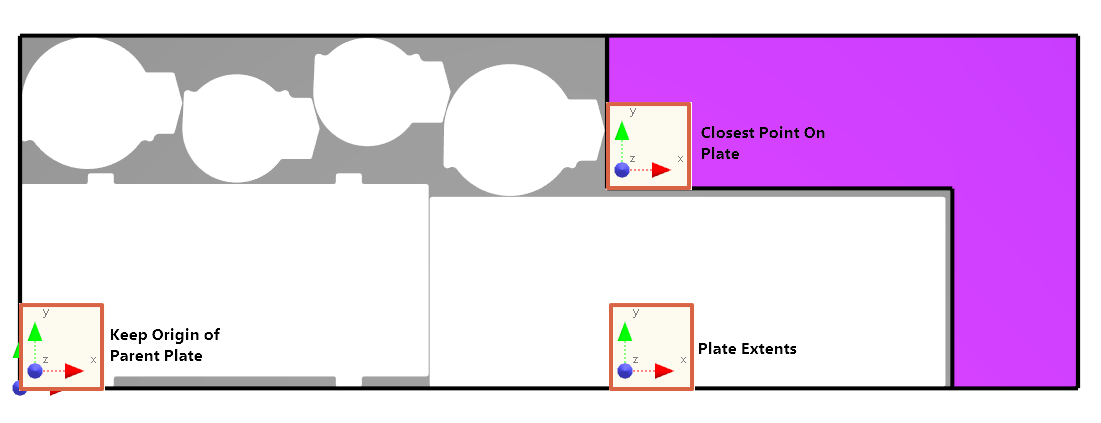Primecut is set up by default to drive a standard Kinetic machine configuration as follows:
Origin is at the bottom left of the plate.
Plate and machine long axis is the X axis, short axis is Y axis.

A typical machine configuration. Note Operator location, and plate and machine axes.

Primecut view of the plate/nest on the table above
Default Plate Origin The plate origin can be moved to other corners of the plate. This is implemented by setting the Plate Origin Offset on each plate. Values other than None or Bottom Left will often result in negative coordinates on one or both axes.
None Default setting. Plate Origin offset is left alone. As plates are generated with the origin at bottom left this is usually the same as Bottom Left.
Top Left Plate Origin Offset X is set to the plate extents min X. Plate Origin Offset Y is set to the plate extents max Y.
Top Right Plate Origin Offset X is set to the plate extents max X. Plate Origin Offset Y is set to the plate extents max Y.
Bottom Right Plate Origin Offset X is set to the plate extents max X. Plate Origin Offset Y is set to the plate extents min Y.
Bottom Left Plate Origin Offset X is set to the plate extents min X. Plate Origin Offset Y is set to the plate extents min Y.
Remnant Plate Origin When an offcut is generated the offcut origin can be reset to a new location. This setting works in combination with Default Plate Origin.
Closest Point On Plate Default The origin is placed on the offcut at the nearest on plate point as per
Keep Origin of Parent Plate The origin stays on the parent plate. If nesting from the left, thus the offcut is to the right, and the origin is bottom left, then then the new origin will not be on the offcut.
Plate Extents The origin will be placed on the corner of the offcut's extents as per Default Plate Origin

Remnant Plate Origin Example: Nest direction is from Left. Offcut has been created to the right (pink). The offcut's origin will be set to one of the three locations shown.
Plate Rotation This allows the plate coordinate system to be rotated so the X axis aligns with any of the four compass pointrs. Often used in conjunction with Default Plate Origin, for example 90 (X down Y Right) may be used with Top Left. Bevel Azimuth Coordinates are also rotated by this setting.
Small Part Alignment Threshold This setting is provided to assist with Small Part Tipup. Default is 200mm (approx 4"); set to 0 to disable .
Max Part Width and Max Part Height Defaults are 0 (disabled). Especially for Plate Dragger style machines, where too-big parts may not fit drop-chutes/tradoors/parts conveyors, or may only fit when nested in certain orientations. These setting control whether parts are nested at all, and if they are the orientation theyare nested in. Max Part Width is the max part size, typically less than or equal to the trapdoor X dimension, Max Part Height is typically less than or equal to the trapdoor Y dimension. Usually Max Part Height is bigger than Max Part Width, and thus long parts are nested "across" the machine, parallel to the machine Y axis, perpendicular to plate travel direction. Set to Zero to disable. Sometimes it is necessary to cut parts bigger than these limits on a machine, but then these parts must be manually unloaded, hence the next setting:
Allow Manual Nesting of Bigger Parts Default is True. Controls whether parts can be manually nested in violation of Max Part Width or Max Part Height.